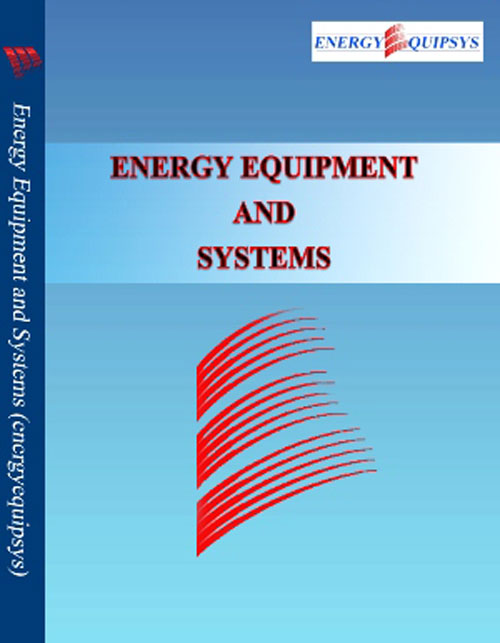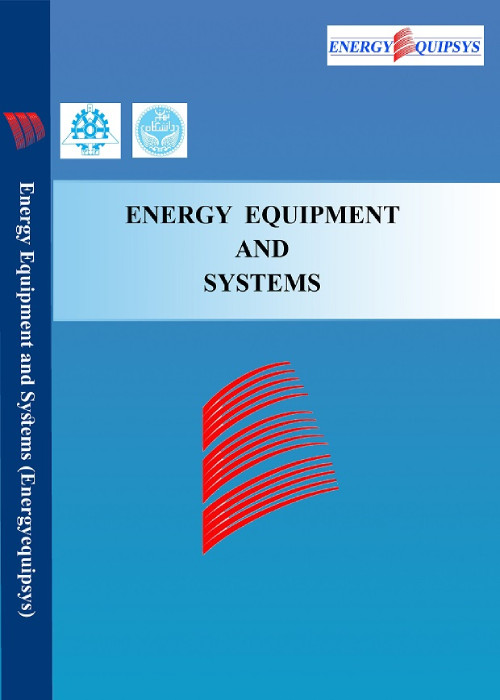فهرست مطالب

Energy Equipment and Systems
Volume:2 Issue: 1, Winter and Spring 2014
- تاریخ انتشار: 1393/02/25
- تعداد عناوین: 6
-
-
Pages 5-24A comprehensive review of fatigue behavior and fatigue design of heavy section wind turbine castings made of ductile iron EN-GJS-400-18-LT is performed. Common metallurgical defects that are affecting fatigue behavior of this material were studied. Review of different researches on quantitative effect of chunky graphite and micro structure on fatigue behavior of EN-GJS-400-18-LT was performed. Finally, safe life design and damage tolerant design of heavy section wind turbine cast iron components were reviewed and compared with each other. It is tried to cover all the required points that should be considered in fatigue design of large EN-GJS-400-18-LT wind turbine castings.Keywords: defect, Ductile cast iron, EN, GJS, 400, 18, LT, Fatigue design, Wind Turbine
-
Pages 25-42Gas-lift pumps are devices for lifting liquid phase incorporating the gas phase to be injected in the bottom of liquid column. They are widely used in various industrial applications such as oil extracting in petroleum industries. Gas-liquid flow being the main part of the flow through these systems, flowing in vertical pipes of gas-lift pumps has different regimes namely bubbly, slug, churn and annular. Considering each numerical method to be appropriate for modeling a certain flow regime, a suitable numerical approach is crucial to correct simulation of gas-liquid flow in upriser pipe of gas-lift systems.
In this paper, two main approaches namely the volume of fluid (VOF) and Eulerian model are used for modeling of the two phase flow in the upriser pipe of the airlift system. The numerical results are compared with the experimental investigations to validate the numerical models. The two phase flow regimes simulated by the numerical method were compared with the available flow regime map in the literatures. The results indicate that using the VOF is more appropriate for modeling of bubbly and slug flows while the Eulerian model fits better for only annular flow regime.Keywords: Airlift pump, eulerian model, numerical modelling, Two phase flow, Volume of fluid -
Pages 43-56This paper presents the aerodynamic design and economical evaluation of a 200 kW site specific wind turbine for the province of Semnan in Iran. By designing site specific wind turbines, the cost of energy which is calculated out of the annual energy production and also the cost of manufacturing the rotor are minimized. The aerodynamic design is based on the well-known blade element momentum theory (BEM) which is integrated with annual wind distribution of the designated wind site to determine the net annual electricity yield for two designed rotors. In the first rotor, a linear fit approximation is used for the chord length and twist angle distributions for ease of manufacturing and to overcome technological barriers in Iran. In the second rotor, the optimum original nonlinear distribution of the blade is assumed. The RISØ-A-24 aerofoil is used and optimized for the design tip speed ratio of λ=8.93 for both rotors. Pitch angle control is also adopted here. A comparison is made between the aerodynamic performance and decrease of manufacturing costs for both rotors. The economic feasibility indicates that based on current electricity costs of 12 cent per kWh in Iran for renewable energies, a profit of 7.2 cent and 8.1 cent per each kWh generated power is achievable respectively by the linear and nonlinear rotor designs. Therefore, the scenario of reducing initial costs is not recommended unless technological shortcoming in manufacturing rotor cannot be avoided.Keywords: Aerodynamic performance, BEM theory, Economical evaluation, Horizontal axis wind turbine (HAWT), Site specific
-
Pages 57-82Recently, many countries have paid substantial attention to power generation from biomass gasification, particularly through small-scale plants. A number of power plant models have been suggested and analyzed; however, certainly, desirable configurations have not been identified yet. Moreover, their performances are ordinarily difficult to compare, especially owing to the fact that working hypotheses are often inconsistent. The objective of this research is to provide an overview on small-scale technologies regarding woody biomass syngas utilization for power production, with the purpose of introducing the most promising solutions from both thermodynamic and economic viewpoints. Existing technologies or those possibly anticipated to be available on the market in the near future have been taken into consideration. Three plant scales have been investigated including 100 kWel, 1 MWel and 5 MWel. As small-scale power plants, internal combustion engines and internal (micro) gas turbines have been taken into account, while gasification has been focused for biomass. Simulations demonstrate that internal combustion engine integrated with an ambient pressure gasifier and regenerative gas turbine integrated with a pressurized gasifier are the most favorable technologies at all the three sizes from a thermodynamic point of view. However, among these two solutions, the former configuration is the most promising one at all the scales from an economic point of view as well.Keywords: Biomass gasification, Electrical efficiency, Gas turbine, Internal combustion engine, Thermoeconomic analysis
-
Pages 83-94An essential requirement for an operating PEM fuel cell is providing proper water content in the membrane. To avoid water flooding an appropriate water balance is required. Here, an analytic model of a planar membrane humidifier for PEM fuel cell is proposed where the effect of dimensional parameters includes membrane thickness, membrane area and channel hydraulic diameter are investigated. A Non-linear governing equations system is developed and solved. At each stage, the outlet temperatures, the water and heat transfer rates, relative humidity and the dew point at dry side outlet are presented and discussed. The humidifier is evaluated based on the decrease in difference between the dew point at wet side inlet and dry side outlet which leads to humidifier better performance. The results show that an increase in membrane thickness results in a decrease in dew point at dry side outlet which indicates a weak humidifier performance. Vaster membrane area can enhance humidifier performance. Here, big hydraulic diameters are not recommended.Keywords: Dew point, Dimensional parameters, PEM fuel cell, Planar membrane humidifier
-
Pages 95-101Conceptual design of a waste heat recovery cycle is carried out in attempt to enhance the thermal efficiency of a steam power plant. In the recovery system, super-critical an CO2 is employed as the working fluid operating in a Brayton cycle. Low grade heat rejected by the flue gases through the stack is used as the primary heat source, while a secondary heat exchanger utilizes the hot gases leaving the economizer to heat of CO2 up to desired temperature. In the present work, a case study for a 325 MW steam power plant of Shazand in Iran is carried out and a thermodynamic model is developed to predict the performance of the system. Regarding that the proposed recovery cycle may lead to less effective air preheating and affecting the combustion efficiency, an optimization process has been conducted to determine the optimum conditions. Its been also considered that excessive decline in flue gas temperature leaving the stack may result in the condensation and accumulation of corrosive substances on the inner surface of the stack. The results demonstrate that this waste heat recovery system can deliver up to 18 MW of net power which corresponds to an increase of 1.58 percent in thermal efficiency of the power plant. Obtained results magnify the importance of this innovative design, consequently illustrate the necessity for using waste heat recovery system.Keywords: Brayton cycle, Super, critical CO2, Waste heat recovery


